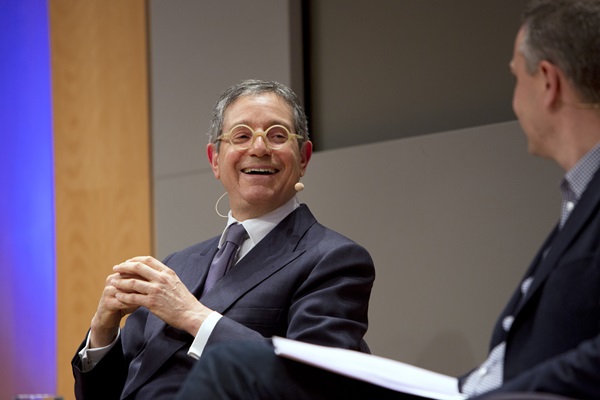
Deitch (left) and Gioni (right).
Photo: Jori Klein/The New York Public Library.
“One of the questions you were going to ask me,” said Jeffrey Deitch, the former director of LA MOCA, to Massimiliano Gioni last night at the New York Public Library, “was what show I regret not having been able to present at MOCA.”
“I wasn’t,” replied Gioni jovially and laughed, “but yes.” The New Museum’s artistic director was signaling to Deitch that he should continue.
“I was sorry,” Deitch said somewhat snidely, “that we weren’t able to present the great Björk retrospective.” The audience unleashed boos and sounds of astonishment. Yes, he was going to go there.
Deitch and Gioni were at the library for its sold out “Live from the NYPL” talk on the occasion of the publication of Deitch’s book Live the Art (Rizzoli, September 2014), which chronicles his time running his storied New York gallery/project space Deitch Projects. And while the talk mostly covered that period of his life, and some of the groundbreaking shows there, it turned at one nearly jaw-dropping moment to his embattled years at MOCA.
Deitch, of course, was referring to the roundly dismissed Museum of Modern Art’s “Björk” show (see MoMA Curator Klaus Biesenbach Should Be Fired Over Björk Debacle and Art World Reacts to Christian Viveros Fauné’s Call for Klaus Biesenbach to Resign). And the parallels between that show, curated by MoMA’s Chief Curator at Large Klaus Biesenbach, and his own unpopular pop-focused programming at MOCA, were too obvious, we guess, to not broach. One of the most highly criticized shows he staged during his tenure was the controversial 2012 James Franco-curated group show “Rebel Without a Cause,” which was staged off-site at the haute furniture showroom JF Chen and dedicated to the popular James Dean film.
Then he backpedaled. “We did a wonderful Björk show at the gallery,” he said, “with Encyclopedia Pictura—we helped produce this astonishing 3D video with Björk ” he said, referring to Wanderlust, which was shown at Deitch Projects’ Long Island space.
Jeffrey Deitch’s book was on sale after the talk.
Photo: artnet News.
“Some of you may have read the diatribes against one of my favorite colleagues Klaus Biesenbach raging today,” he said, noting how he was attacked by the critics and the press then as Biesenbach is currently. “[It] reminds me of the diatribes that went on against me when I was at MOCA…. So with Klaus, it’s Bjork; with me, it was James Franco, unfortunately.” This generated much laughter from the audience.
“I enjoy this whole back and forth, it’s part of what makes our world fun and interesting. But this is a fascinating thing that’s going on now.” (See Ladies and Gentlemen, the Björk Show at MoMA Is Bad.)
Deitch conveyed his attraction to artists with “cross-over quality”—Michel Gondry being interested in presenting his work in an art context, and Jordan Wolfson being interested in making a feature film (see Say Hello to Jordan Wolfson’s Terrifying Animatronic Dancer at David Zwirner).
“So, this is a very interesting challenge to the old-fashioned art world,” he said. “And what I see as the more academic elite, can no longer control the dialogue. Because there’s a big audience who responds to art that has more cross-over quality. I’m a firm believer that just because art is more popular and engaging doesn’t mean that it’s not serious.”
The silence in the room during the talk, which was attended by creative luminaries including Cecilia Alemani and W Magazine editor Stefano Tonchi, was a testament to the truly fascinating details that make up Deitch’s life story. Despite the fallout at MOCA, one can’t help but be captivated by his story-telling.
One last detail we’ll regale you with involved Michael Jackson, Kehinde Wiley, and the billionaire industrialist and owner of a Jeff-Koons-designed yacht Dakis Joannou and his pied–à–terre at Trump Tower.
When he started his own business, one of his long time clients, Dakis Joannou, had a small apartment in Trump Tower that “he wasn’t really using.”
“I said how about a barter deal,” said Deitch. “Art advisory services in exchange for using your apartment. He said, ‘of course.’ That was one of the ways I started my business with no money.”
At some point during Deitch’s barter deal, Michael Jackson was making an album in New York and spent six months in a Trump Tower apartment. “It was amazing to see him come in,” said Deitch. “Late at night, he’d come from the studio. He worked very hard.”
Jeff Koons, Michael Jackson and Bubbles (1988).
Photo: via Wikipedia.
As Deitch told it, he was working with Jeff Koons at the time and bribed one of the doormen to put a copy of a Jeff Koons’s catalogue in his apartment, the one with Koons’s 1988 sculpture Michael Jackson and Bubbles on the cover.
“’When you get access to the apartment,’” said Deitch recalling what he said to the doorman, “’could you leave this Jeff Koons catalogue with Michael Jackson and Bubbles on the cover with this note from me?’ The note said, ‘we would like to sell to you this sculpture of you.’”
Eli Broad ended up buying it. But years later, Deitch heard again from Jackson when the pop star got interested in the work of Kehinde Wiley. He recalled the portrait of Jackson currently on view at the Wiley show at the Brooklyn Museum. (See Kehinde Wiley’s New Takes on Old Masters Get Brooklyn Museum Survey.)
“We were actually able to arrange this conversation between Michael and Kehinde,” said Deitch. “Kehinde claims to have it on tape.”
As for the portrait of Jackson. “He didn’t end up buying that one either,” said Deitch. But Jackson did leave a lasting impression. “[Wiley] couldn’t believe Michael’s knowledge of old master painting and art history.”